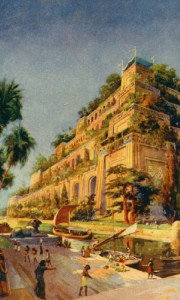http://critical-hits.com/2012/02/15/the-architect-dm-seven-wonders-of-your-world/
Información:
The Architect DM: Seven Wonders of Your World
 Whenever I get a chance I make a pointed effort to read about or look at a map of other DM’s and GM’s roleplaying game worlds. I find it fascinating to look at them both objectively and subjectively, to see things that I may never have come up with or elements that are similar to things in the worlds I’ve created. Over the last few years, I’ve noticed a handful of elements that pop up in the majority of people’s fantasy game worlds and these elements have been some of the inspiration for earlier world building posts in my Architect DM posts.
Whenever I get a chance I make a pointed effort to read about or look at a map of other DM’s and GM’s roleplaying game worlds. I find it fascinating to look at them both objectively and subjectively, to see things that I may never have come up with or elements that are similar to things in the worlds I’ve created. Over the last few years, I’ve noticed a handful of elements that pop up in the majority of people’s fantasy game worlds and these elements have been some of the inspiration for earlier world building posts in my Architect DM posts.A great place to start with world building is to take inspiration or replicate an element from the real world. Today I’d like to talk about the concept of theSeven Wonders of the Ancient World and how more people should apply it to their game worlds. One of my favorite aspects of this idea is that featuring exactly seven aspects of a world seems to be a perfect balance between highlighting diversity and summarizing generalities.
Adding Wonder to a Mundane World
When I visualize the “typical DM’s D&D world map” I see something that has wiggly lines for coast lines, land split up by forests, mountains, and maybe some rivers or lakes, and a sprinkling of towns that seem to be placed randomly with some scraggly roads connecting them. I’ve tried to write several posts to help you design a believable and interesting world map from scratch or to adjust what you’ve already designed, so I’m not going to go into the general concepts behind fixing what I’ll call the “boring old D&D world”. If you have a question about general fantasy world design, please share it with me and I’ll address it in a future post!
What I think is missing from a lot of these game worlds and maps are featured elements that stand out from the background of the rest of the world. Though I referenced the Wonders of the Ancient World, these can be natural, man-made, or any other kind of wondrous element you can think up for your world. Add a Thunderspire into the midst of your largest mountain range, draw a giant tree in the middle of one of your forests (maybe even call it Yggdrasil, Teldrassil, or any other kind of *drasil you like), and show a prominent wizard’s tower as the focal point for a major city.
The Building Blocks of Story
Adding Wonders to your game world not only gives the players sign posts that help them navigate the world and differentiate one region from another, but they also present a great foundation for adventures and stories that you and your players can explore. This might feel like a shortcut or skimping on world building, but if you think about running a modern game in the present world it really starts to make sense. If your players visit Egypt, I don’t think they would be disappointed with the adventure focusing on a series of dungeons buried beneath the Pyramids. Or if you run a historic game and the players are sailing to Rhodes, you better believe they’ll want to hear about the Colossus.
The best part about adding these elements to your game world is that you can (and should) borrow liberally from real life. Add a Grand Canyon or Niagara Falls to your game world, just give them a new name or change a few of the key features about them and you’re set. George R. R. Martin did this in the Song of Ice and Fire series with the Titan of Braavos and it was one of my favorite elements of the series.
An Overly Wondrous World
I would probably argue that you can’t add too many wonders to your game world, but I would recommend sticking to a nice list of seven and seeing how your world looks after that. If you really want to add more features, I would recommend creating a list of seven natural wonders, seven ancient wonders, and seven modern wonders of your game world. From there you should have a fantastic spread of elements on which to build stories and to entice your players to explore the world with little extra encouragement.
The idea of presenting ancient wonders and natural wonders in your game world presents a nice view of history and can inspire wonder based on the unanswered questions they bring up. You can tie natural wonders to a god’s acts of creation or to indicate natural forces at work in your world. Ancient wonders can provide the perfect gateways for you and your players to explore your game’s history or to set up ongoing plots that give your world a nice “lived-in” feeling. Modern wonders can round out your world and can even interact with the ancient and natural wonders in your game world. Imagine a Taj Mahal built in the middle of Niagara Falls, or a fantasy equivalent of the race to build the world’s tallest building.
I’ve never been a huge fan of the Forgotten Realms D&D setting, but upon looking into it in the last few years while running my campaign I was surprised at the number of wondrous elements that were spread around the map. It felt like every region had its one special/unique element that defined it, and very little or even none of the world map was left over to serve as background for the important elements. For a published campaign setting I actually think this is fine, but if you’re creating your own fantasy world I wouldn’t recommend going the route of the Forgotten Realms. Instead, look at the maps for settings such as Dark Sun and Eberron and take note of the way wonderous landmarks are used to define certain regions. A perfect example is the Lightning Rail in Eberron, which immediately effects the DM and player impressions of the regions it connects and can inspire all kinds of adventures and encounters entirely on its own.
Click here for the rest of the Architect DM Series.
Danny works professionally as an architect and serves as managing editor here at CH, which means he shares many of the duties of being an editor but without the fame and recognition. He also writes about RPGs, videogames, movies, and TV. He is married to Sucilaria, and has a personal blog at Incorrect Blitz Input. (Email Danny orfollow him on Twitter).
Comments
4 Responses to “The Architect DM: Seven Wonders of Your World”Trackbacks
Check out what others are saying about this post...- [...] your campaign setting include a set of “Seven Wonders”? Bartoneus at Critical Hits thinks more people should use them. And I definitely agree – a few well-placed wonders can definitely spice up world history, [...]
- [...] The Architect DM: Seven Wonders of Your World [...]








Of course, natural wonders in a D&D game might include fantastical elements as well. Imagine a Niagara Falls that flows backwards, an Everest made of mammoth chunks of quartz, or a grand canyon that spawns predictable ‘old-faithful’ style tornadoes down its length.